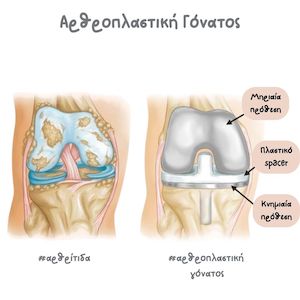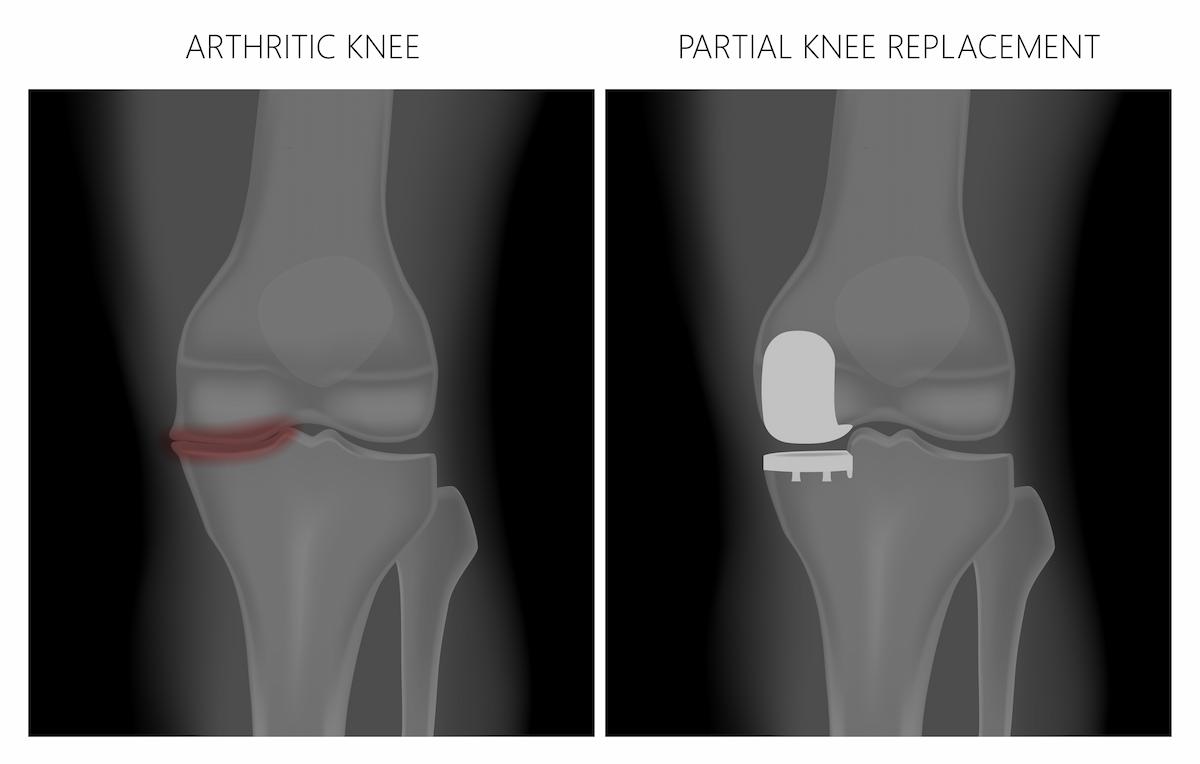Georgios Panagopoulos MD | Orthopaedic Surgeon

Table of contents
What is knee arthroplasty?
Knee arthroplasty, also known as knee replacement, is a common surgical procedure that involves replacing the worn or damaged knee with an artificial joint. A knee arthroplasty can be performed at any age but is more common in patients of 60-80 years of age. A partial knee replacement (sometimes called a “uni”) may be performed in younger individuals. The artificial joint usually consists of metal implants (made of metal alloys) with a high-grade plastic polymer in between as a spacer (polyethylene).

Why do I need a knee arthroplasty?
The most common indication for knee arthroplasty is osteoarthritis. Most patients are over 50 years of age.
Other indications include rheumatoid arthritis, gout, post-traumatic arthritis, haemophilia, osteonecrosis of the knee.
You will typically be offered a knee arthroplasty if you have significant pain and severe knee dysfunction, that interferes with your sleep and activities of daily living, your work and social life overall.
What happens before the procedure?
Before knee arthroplasty, you will typically undergo preoperative assessment. You will be asked about your health history in detail. You will be asked to bring along a full list of your medications. You may need to stop taking some of your medications a few days before surgery (especially blood thinners). Before the procedure, you may also need blood tests, a chest x-ray and an ECG (electrocardiogram) or cardiology consult, to make sure it’s safe to proceed with surgery. The anaesthetist will give you specific preoperative instructions, including how long before surgery to stop eating and drinking. Typical recommendations usually suggest no eating or drinking at least six hours prior to surgery.
Admission to hospital - Anaesthesia
Knee arthroplasty is performed under either general anaesthetic (you will be put to sleep) or under spinal anaesthetic (the lower half of your body will be numbed). This is a decision to be made after a discussion between the patient, the anaesthetist and the surgeon.
What happens during the procedure?
The patient is placed supine (on their back) on the operating table. A straight incision is performed centered over your kneecap. Soft tissues are then further incised in order to evert the kneecap getting it out of the way. The surface of the bone at the bottom of the femur and on top of the tibia are cut with special jigs in order to prepare the surfaces for the implants. The collateral ligaments on the sides of the knee are preserved. The ACL is typically cut, whereas the PCL might or might not be cut, depending on the specific implant design used. The implants are then inserted in place with the aid of bone cement, that takes about 10 minutes to set. A hard plastic insert (“poly”) is placed between the metal implants. The back of the kneecap may or may not be replaced (patella resurfacing), based on surgeon preference. Soft tissues and skin are sutured back together, and a dressing covers the surgical site.
Most patients with knee osteoarthritis have disease spread in all compartments of the knee.
For osteoarthritis limited in 1 compartment, an alternative procedure is called unicompartimental arthroplasty, which can have great results in carefully selected patients.
Dr Panagopoulos will discuss with you what's the best option for your specific case.
The advantages of unicompartimental arthroplasty may include:
- Quick recovery
- Less postoperative pain
- Less blood loss
- Less postoperative complications
A potential disadvantage of a unicompartimental arthroplasty is the likely future need for revision to total knee arthroplasty.


What to expect after the procedure?
Hospital is usually about 3 days, but this may vary. You will see your surgeon and get postoperative instructions prior to discharge from the hospital. You'll need to use crutches or a frame for the first few weeks. Your physiotherapist will teach you exercises to help strengthen your knee. Most people can stop using aids around 6 weeks after surgery and start driving after 6-8 weeks. Your surgeon and physiotherapist will prepare a customized rehabilitation plan for you.
What's the cost of the procedure?
The final cost of the procedure depends on many factors, but is reasonable. Please contact us for more information.
FAQs - Frequently Asked Questions
What is knee arthroplasty?
Knee arthroplasty, also known as knee replacement, is a common surgical procedure that involves replacing the worn or damaged knee with an artificial joint.
Which is the most common indication?
The most common indication for knee arthroplasty is osteoarthritis. Most patients are over 50 years of age.
When can I have a "uni"?
For osteoarthritis limited in 1 compartment, an alternative procedure is called unicompartimental arthroplasty, which can have great results in carefully selected patients.
Find us
Book an appointment with us today
